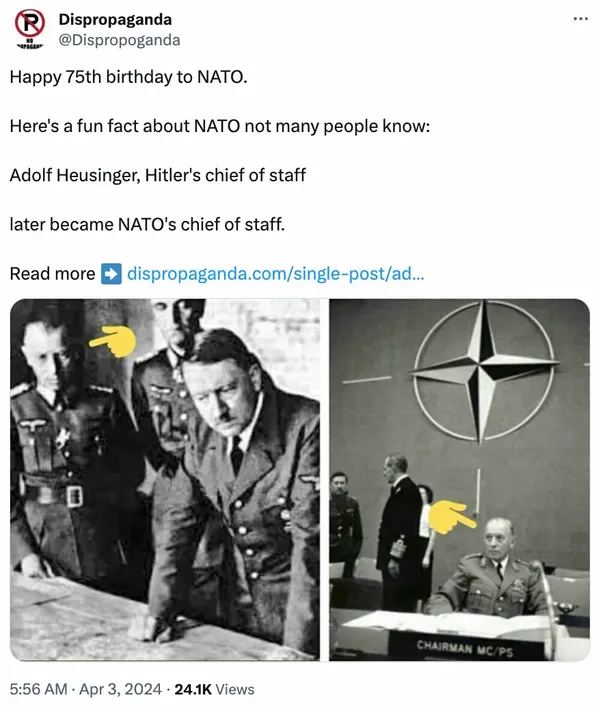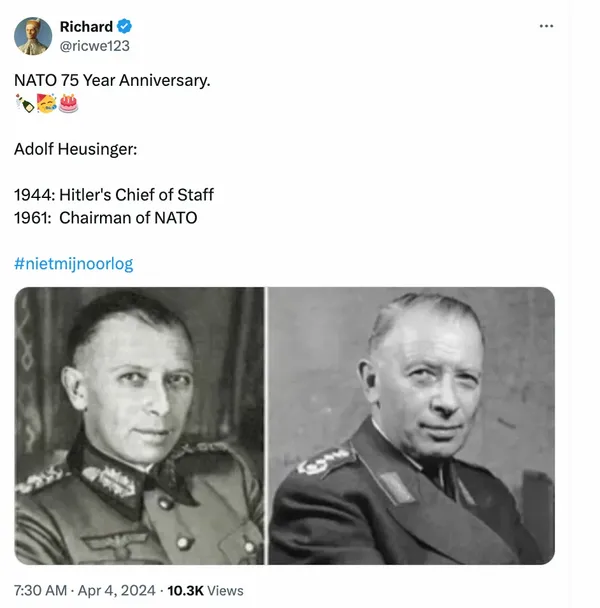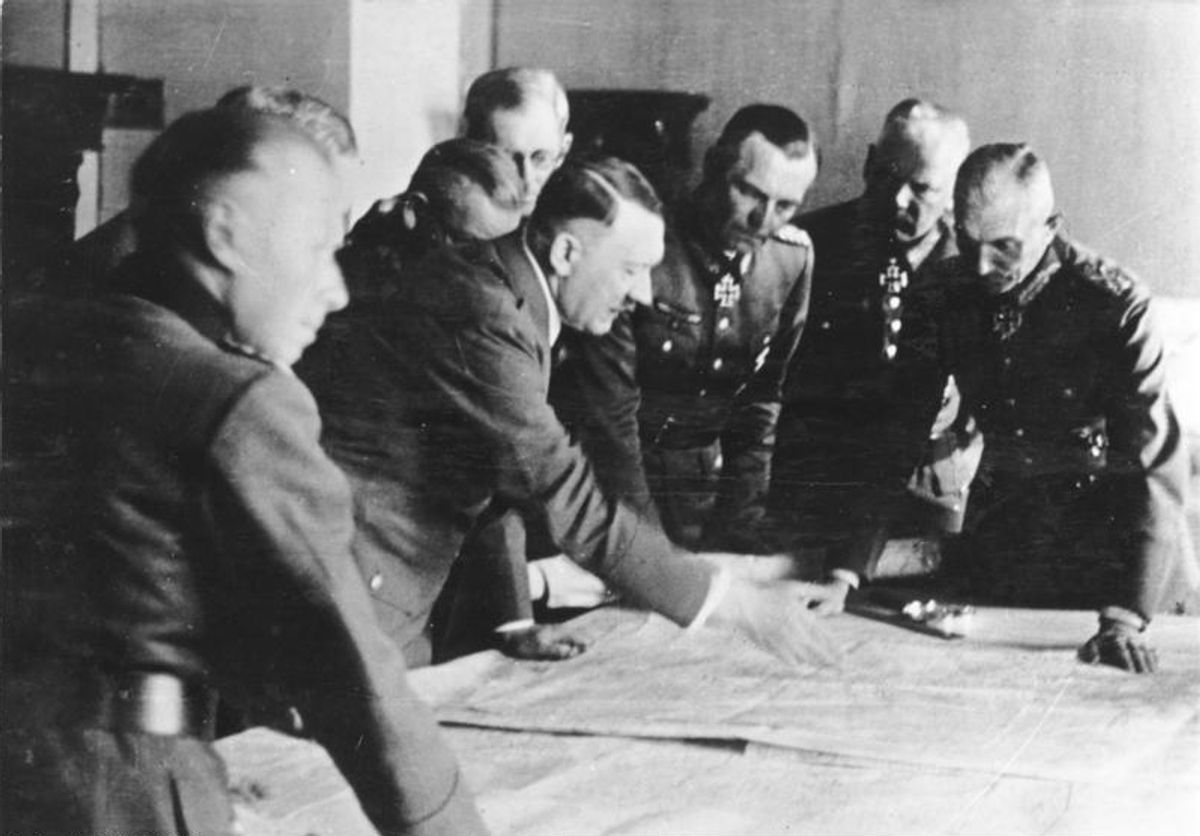Gen. Adolf Heusinger was chief of army operations in the Nazi army and briefly filled in for Gen. Kurt Zeitzler, the chief of the German army's High Command. In 1961 he became chairman of NATO's Military Committee, where he directed chiefs of staff who represented different countries.
Heusinger did not hold the title of "chief of staff" for an extended period of time in the German army, though he was a high-ranking official in both the Nazi army and later head of the Military Committee of NATO.
On April 3, 2024, viral posts claimed that Nazi leader Adolf Hitler's chief of staff later became the chief of staff for the North Atlantic Treaty Organization created after World War II. The posts stated that Adolf Heusinger was in "1944: Hitler's Chief of Staff" and in "1961: Chairman of NATO" or "chief of staff." The title "chairman" and "chief of staff" is used interchangeably in the posts.
We should note, NATO has a chairperson for the Military Committee, the organization's highest military authority, which is in turn made up of chiefs of defense (also referred to as chiefs of staff) who are officers representing each member country.

(X user @Dispropoganda)

(X user @ricwe123)
The above posts are partially true in that they correctly identify Heusinger as a high-ranking official for the German army under Hitler and for NATO later on, but he did not hold the permanent title "chief of staff" (only briefly filling in that role once), nor was he "chief of staff" of all of NATO. He was chairman of the military committee of NATO, which is the highest military authority in the organization. As such, we rate this claim a "Mixture" of truths.
During World War II, Heusinger was a high-ranking officer in Hitler's army. The United States Holocaust Memorial Museum identified him as the "Chief of Army Operations."
In 1961, U.S. Sen. Wayne Morse put together a "Fact Sheet" about Heusinger, protesting his appointment to a leadership position in NATO (not chief of staff, which we'll come back to). The sheet is available in congressional archives and noted that Heusinger was appointed "chief of operations on Hitler's general staff" in 1940, and was thus responsible "for the military planning of all Nazi invasions from then on."
The sheet also noted:
Heusinger, as chief of operations of the OKW (Oberkommando der Wehrmacht) — the high command for the Nazi forces, commanded the special extermination squads. … These squads were given the task of exterminating all Jews and other groups.
Morse added that Hitler called Heusinger "my true and loyal collaborator."
A CIA report on Heusinger noted:
In 1937 he was assigned to the Plans and Operations Division of the Army General Staff, the division charged with operational responsibility for planning the occupation of Austria, the Sudetenland, the interior of Czechoslovakia and Memel, as well as the Polish, French, Balkan and first stages of the Russian campaigns. From 1937 until 1940 Heusinger was first assistant to the chief of the division, and from 1940 until 1944 he served as its chief. By 1936 he had achieved his majority; thereafter, successive promotions advanced him to Lieutenant Colonel in 1939, Colonel in 1940, Brigadier General in 1941, and Major General in 1943.
In the book, "Operation Valkyrie: The German Generals' Plot Against Hitler" by Pierre Galants, Heusinger gave his personal account of the disintegrating loyalty of Hitler's top commanders and their plan to kill Hitler. According to the CIA report, in 1944, Heusinger was standing next to Hitler when a bomb exploded, which failed to kill the leader:
On July 20, 1944, Heusinger was standing beside Hitler when the Stauffenberg bomb was detonated. Wounded by splinters from the explosion, he was hospitalized briefly and then taken to a Gestapo prison when it became known that he was aware that preparations were being made for a coup. After admitting to the Gestapo that he had not approved of Hitler's military decisions and wished that the Fuehrer would return the supreme command to the soldiers, he was released for lack of evidence and retired.
According to "Operation Valkyrie," in 1944 Heusinger was considered as a replacement for Gen. Kurt Zeitzler, who had been chief of the German army's High Command (OKH) since 1942. (This was a different position from the Armed Forces High Command (OKW), led by Wilhelm Keitel. OKW was effectively Hitler's high command or war ministry, but it was not a unifying body; the OKH maintained a dominant position under Hitler and kept its independence from the OKW.) According to Heusinger's own account, he refused to be considered for the position, telling other officers:
Not I, gentlemen, if you please. You know that I've been trying to leave for some time now. As far as I'm concerned, this system of command is both exhausting and infuriating. I'll never be able to get Hitler to agree to anything … He wants his chief of staff to be obedient to a fault, with no personal opinions of his own, someone who will be occupied exclusively with the technical workings of the machinery of command — while he continues to take care of everything else himself. With Zeitzler gone, you will not find another chief of staff, in the traditional sense, to replace him. … I can only think of one solution: Abolish the dual command [OKH and OKW], put both of them under the direction of a single individual, and take the responsibility for the daily conduct of operations out of Hitler's hands.
In early July 1944, he stepped in for Zeitzler at the daily briefings at Hitler's General Headquarters after Zeitzler took ill. On July 20, the assassination attempt took place. Heusinger may have temporarily been filling Zeitzler's position, but his primary role was not as chief of staff for either the OKH or OKW.
Per Morse's 1961 document, "There is strong suspicion that Heusinger informed and gave Hitler and the Gestapo the names of the plotters in order to save his own neck."
At the end of the war, Heusinger surrendered to the U.S. Army and was investigated as a war criminal "in connection with certain orders he signed and forwarded which sealed the fate of captured Russian political indoctrination officers and Allied commandos," according to the CIA. However, because of his cooperation at the Nuremberg trials — held by Allied Forces to bring Nazi war criminals to justice — and findings showing he had only initialed the orders during their transmission, no action was taken against him.
After the war, Heusinger joined the intelligence services of West Germany. By 1957, he was promoted to the rank of full general and was appointed inspector general of the West German armed forces.
Heusinger was appointed chairperson of NATO's Military Committee in 1961, according to NATO's website. The Military Committee is responsible for providing consensus-based advice on military policy and strategy to the North Atlantic Council and direction to NATO's strategic commanders. According to congressional records from 1961, Morse detailed opposition to this from Jewish activists and the American Jewish Congress.
In 1964, Heusinger retired as the head of NATO's Military Committee, according to the New York Times. He called for the addition of a West German major general to NATO's Standing Group — the highest strategizing body in the alliance — made up of representatives from the United States, Britain and France. However, by 1966, the Standing Group was abolished and its powers transferred to the Military Committee.

